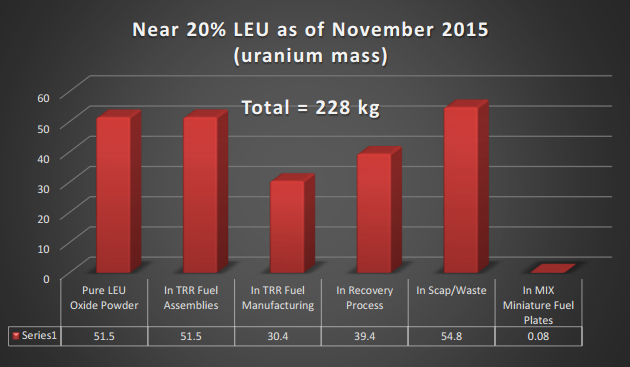Reports
Taking Stock of Iran’s Near 20 Percent LEU
by David Albright and Serena Kelleher-Vergantini
December 14, 2015
Iran continues to hold a relatively large stock of near 20 percent low enriched uranium (LEU), much of which will need to be blended down or be shipped out of Iran under the terms of the Joint Comprehensive Plan of Action (JCPOA). None of this LEU is in hexafluoride form (UF6), but it is in several other chemical forms. Under the JCPOA, Iran has agreed to retain only the near 20 percent LEU that has been manufactured into Tehran Research Reactor (TRR) fuel plates. So far, Iran has had very low efficiency rates in TRR fuel production, meaning that very little of the LEU has actually been manufactured into fuel while most of it has ended up in scrap and waste or remains as an oxide powder. Iran is now in the process of recovering near 20 percent LEU from its scrap so that it can manufacture more of it into fuel before Implementation Day. Thus, the amount of LEU to be blended down or sent out of Iran remains unknown but could be a sizeable fraction of its inventory. It is imperative that Iran abide strictly with the JCPOA and reduce, by Implementation Day, its relatively large domestic stock of near 20 percent LEU to the amount contained in TRR-usable fuel elements, i.e. its near 20 percent LEU in scrap, waste, in process, and defective fuel plates must be reduced to near zero kilograms by Implementation Day.
As of the end of the last International Atomic Energy Agency (IAEA) safeguards reporting period in November 2015, Iran had only 51.5 kilograms (kg) of near 20 percent LEU (uranium mass) in TRR fuel out of an inventory of about 228 kilograms of LEU (uranium mass).1 This is just 22 percent of the total LEU.
So far, Iran has registered very low efficiency rates in TRR fuel production, generating large amounts of valuable scrap. At the start of the last reporting period in August 2015, Iran had 138.9 kg of near 20 percent LEU in scrap, waste, and in process generated by the conversion into oxide and subsequent fuel manufacturing process.
Given that most of Iran’s near 20 percent LEU ended up in scrap and waste, in order to utilize this LEU in fuel, Iran started the process to recover the uranium and use more of it for fuel manufacturing before Implementation Day. Between August and November, Iran fed 95.9 kg of the 138.9 kg of scrap and waste into the uranium recovery process. From this material, Iran recovered 44.7 kg of near 20 percent LEU oxide powder and used 30.4 of it for TRR fuel manufacturing. However, the recovery of the uranium contained in the 95.9 kg generated 11.8 kg of uranium in liquid and solid scrap, while 39.4 kg are still believed to be in the recovery process. The 30.4 kilograms, while assigned to fuel manufacturing, are not believed to have been actually made into fuel as of late November.
In sum, as of November 2015, Iran possessed about 228 kg of near 20 percent LEU (uranium mass). Although none of this material is in hexafluoride form (UF6), 51.5 kg remain in pure oxide powder form, 30.4 kg are believed to be in the process of TRR fuel manufacturing, 51.5 kg are in TRR fuel assemblies, 39.4 kg are in the recovery process, and 54.82 kg are in scrap and waste (see Figure 1).2
According to the terms of the JCPOA, Iran will be able to retain only the near 20 percent LEU that is manufactured into usable TRR fuel plates. All near 20 percent LEU not present in usable TRR fuel plates, whether in oxide or other forms not suitable for fuel manufacturing, will have to be transferred out of the country or diluted to an enrichment level of maximum 3.67 percent by Implementation Day.
To ensure effective implementation of the JCPOA, it is important that all of Iran’s near 20 percent LEU in scrap and waste be deemed unfit for use in TRR fuel and sent out of Iran prior to Implementation Day, since dilution would likely be overly difficult. Near 20 percent LEU in powder form must be made into fuel by Implementation Day; the remainder must be shipped out or diluted by then.
A concern relates to the possible interpretation of the provisions relating to the near 20 percent LEU in scrap and waste. According to Annex 1 of the JCPOA: “Scrap oxide and other forms not in plates that cannot be fabricated into TRR fuel plates will be transferred, based on a commercial transaction, outside of Iran or diluted to an enrichment level of 3.67% or less.” We recommend that this provision is interpreted as covering all the uranium in scrap, waste, and in process. Iran may try to argue that some of the LEU can be kept in fuel plates, even if the plates are defective or not of sufficient quality to be used in the TRR. Any Iranian attempt to keep this material should be opposed.
It is imperative to scrutinize the process of removing LEU from Iran to ensure that this JCPOA condition is implemented adequately, and Iran’s relatively large domestic stock of near 20 percent LEU in scrap, waste, and process is reduced to near zero kilograms by Implementation Day.

1 Of these 51.5 kg, only about 20 kg have been irradiated in the Teheran Research Reactor. Iran has irradiated only one additional standard fuel assembly since the last reporting period. 2 A small percentage of this number could still be in process.

 twitter
twitter